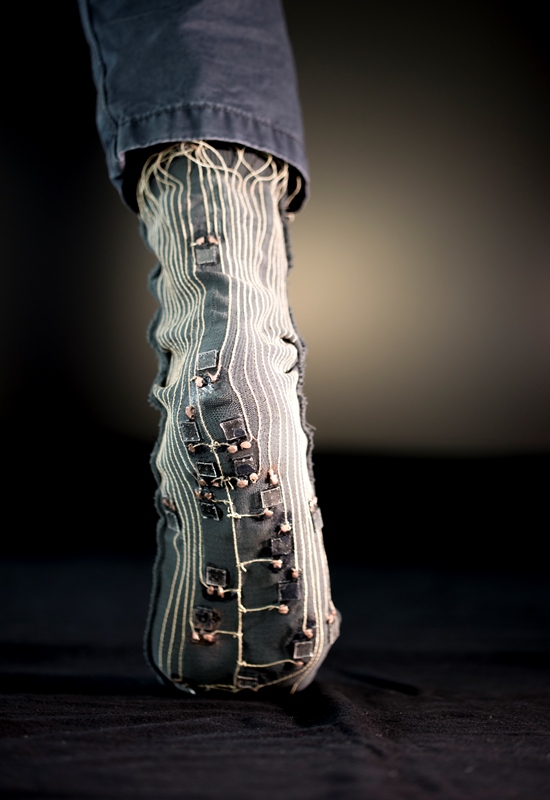Sensor patches, loud speakers and power generators made up of rubber

New textile-integrated pressure sensors can take 3D measurements, e.g. in special socks for diabetics. Results can be checked on a smart phone. Photo: K. Selsam-Geißler for Fraunhofer ISC
CeSMa research focuses on smart materials able to perform controllable sensor or actuator functions. In particular, the elastomers which are switchable by applying magnetic or electric fields and which consist predominantly of silicone, offer great potential for a wide variety of industrial applications.
As capacitive measuring sensors they function as a strain or pressure sensor. They are adaptable to almost any given situation and can be even integrated into textiles. Compared to conventional solutions they save energy, weight, material, and production costs.
Owing to the iron particles embedded in their soft matrix, magnetorheological elastomers (MRE) can be magnetically controlled and so are able to perform complex movements. Their simple design also makes them an alternative to conventional electric motors or magnetic switches. Applications include dampers, seals, valves as well as soft haptic elements like buttons and grippers.
Dielectric elastomer actuators (DEA), on the other hand, are composed of insulating elastomer films coated with highly flexible electrodes on both sides. When voltage is applied to the electrodes, the thickness of the elastomer film decreases through the interaction between the oppositely charged layers. This principle can be applied to noiseless, ultra-light linear actuators used as muscles in artificial prostheses or robotic grippers. DEAs can be integrated as diaphragms in extremely thin and lightweight loud speakers.
With pressure or draught the elastomeric films change their thickness area ratio and thus the capacity as indicator. These dielectric elastomer sensors (DES) can be manufactured at low cost and are suitable as large flexible sensors of very good chemical, thermal and mechanical stability, for example for pressure distribution measurement in seats or mattresses.
The elastomer sensors can also be integrated into textiles and permit a three-dimensional pressure measurement through a specially developed stocking for diabetics that warns of pressure sores.
Sensor patches with an area of 1 cm² and a thickness of 2 mm can record pressure or strain even in inaccessible places.
Beyond the strain measurements additionally integrated conductive layers are able to detect the approach of a foreign object. This offers the possibility for elastic collision protection coatings for human-machine interfaces.
Dielectric elastomer generators (DEG) enable innovative, eco-friendly energy harvesting obtained through low water flows of small rivers. The pressure – generated with a gentle pipe system (Venturi principle) – leads to a periodic elongation and relaxation of the elastomer films. With the help of an electronic circuit this mechanical stretching is directly converted into electrical energy. In contrast to conventional regenerative energy converters DEGs don’t generate optical or acoustic disturbances of the environment. The use of these generators is suited for campsites or charging stations for electric bikes and cars in rural areas.
Media Contact
All latest news from the category: Trade Fair News
Newest articles

Parallel Paths: Understanding Malaria Resistance in Chimpanzees and Humans
The closest relatives of humans adapt genetically to habitats and infections Survival of the Fittest: Genetic Adaptations Uncovered in Chimpanzees Görlitz, 10.01.2025. Chimpanzees have genetic adaptations that help them survive…

You are What You Eat—Stanford Study Links Fiber to Anti-Cancer Gene Modulation
The Fiber Gap: A Growing Concern in American Diets Fiber is well known to be an important part of a healthy diet, yet less than 10% of Americans eat the minimum recommended…

Trust Your Gut—RNA-Protein Discovery for Better Immunity
HIRI researchers uncover control mechanisms of polysaccharide utilization in Bacteroides thetaiotaomicron. Researchers at the Helmholtz Institute for RNA-based Infection Research (HIRI) and the Julius-Maximilians-Universität (JMU) in Würzburg have identified a…



